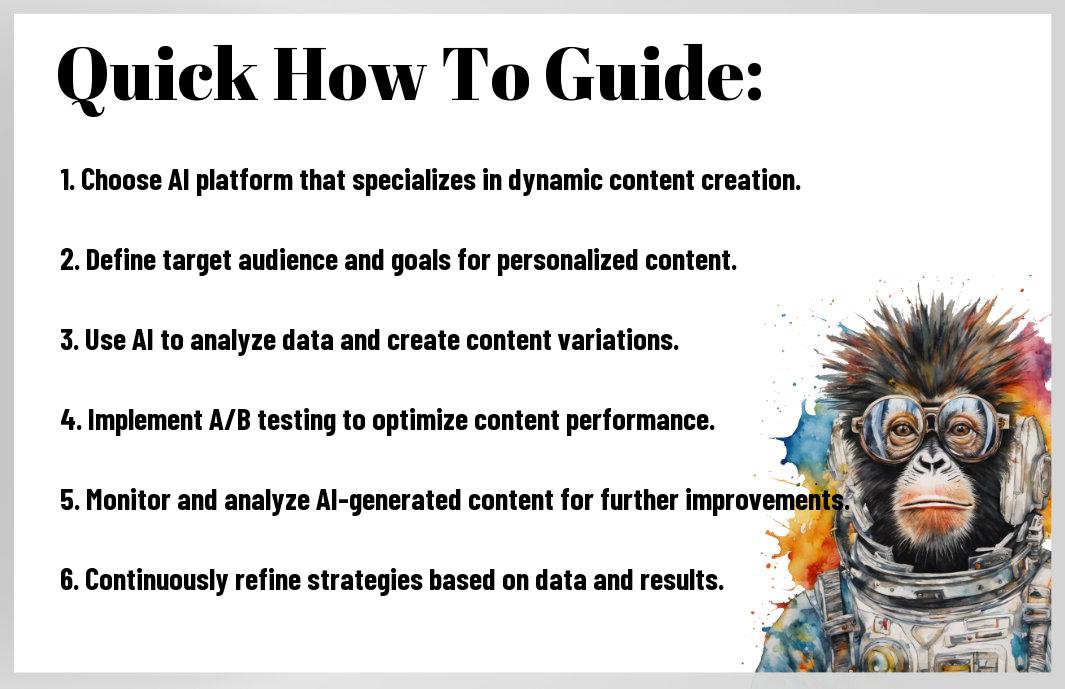Most marketers are always on the lookout for innovative ways to improve content creation processes. Leveraging artificial intelligence (AI) is one such solution that can streamline and enhance dynamic content creation. In this blog post, we will explore the best practices and techniques for utilizing AI in your content creation strategy. For more in-depth insights, check out Mastering AI Content Creation: Best Practices to Build a …
Understanding AI-Powered Content Creation
How AI is Revolutionizing Content Generation
For businesses looking to streamline their content creation process, AI is a game-changer. With AI-powered tools, companies can generate dynamic and personalized content at scale, saving time and resources while still maintaining a high level of quality.
Key Benefits of AI-Driven Content Creation
You can expect increased efficiency, improved scalability, and enhanced personalization with AI-driven content creation. These tools can analyze data to understand consumer preferences and create content that resonates with specific target audiences, leading to higher engagement and conversion rates.
Understanding AI-driven content creation involves grasping the concept that AI algorithms can analyze vast amounts of data to generate content that is tailored to the target audience’s preferences. By leveraging machine learning and natural language processing, businesses can create more relevant and engaging content, ultimately improving customer interactions and driving business growth.
Tips for Implementing AI in Content Creation
There’s no denying the potential of AI in revolutionizing content creation. Here are some tips to help you effectively implement AI in your content creation process:
- Identify the right AI tools for your needs
- Develop a content strategy that leverages AI
- Implement best practices for human-AI collaboration
Throughout your AI implementation journey, remember to refer to 13 Ways to Scale Content Personalization With AI for additional insights.
Identifying the Right AI Tools for Your Needs
Clearly defining your content creation goals and requirements will help you identify the most suitable AI tools for your specific needs. Consider factors such as the type of content you produce, your target audience, and the level of personalization you aim to achieve.
Developing a Content Strategy that Leverages AI
Content creation that integrates AI requires a strategic approach to ensure optimal results. Needs thorough planning, including setting clear objectives, defining key performance indicators (KPIs), and establishing a feedback loop to continuously improve your AI-powered content strategy.
Best Practices for Human-AI Collaboration
Identifying the roles and responsibilities of both humans and AI in the content creation process is necessary for successful collaboration. Tips for creating a seamless workflow include providing adequate training for team members, setting up clear communication channels, and conducting regular performance evaluations to assess the efficiency of the human-AI partnership.
Factors to Consider When Utilizing AI for Content Creation
Your content generation strategy can greatly benefit from the implementation of AI technologies. However, to ensure optimal outcomes, it is necessary to consider the following factors:
- Algorithm Accuracy and Relevance
- Data Quality and Quantity
- Customization and Personalization
- Ethical and Legal Compliance
- Scalability and Integration
Any successful AI-driven content creation strategy will prioritize these factors to achieve the desired results effectively.
Ensuring AI-Generated Content Meets Quality Standards
When utilizing AI for content creation, it is crucial to establish quality standards and guidelines to ensure that the generated content meets your expectations. Regularly review and optimize the AI algorithms to maintain the desired level of quality.
Addressing Ethical Concerns and Bias in AI-Driven Content
To address ethical concerns and biases in AI-generated content, it is vital to implement diverse data sets and regularly audit the algorithms for any discriminatory patterns. This ensures that the content produced is fair, unbiased, and complies with ethical standards.
For instance, AI-powered content creation tools can unintentionally propagate stereotypes or misinformation if not properly monitored and regulated. Regular audits and oversight are necessary to mitigate these risks and ensure ethical content creation.
Scalability and Cost-Effectiveness of AI-Powered Content Creation
Now, with advancements in AI technologies, scalability and cost-effectiveness are crucial considerations for content creation. AI-powered tools can efficiently handle large volumes of content creation tasks while reducing operational costs. Scalability ensures that the content generation process can adapt to changing requirements and demands, making it a sustainable solution for businesses of all sizes.
This dynamic approach enables businesses to streamline their content creation processes, reduce manual intervention, and optimize resources effectively, ultimately leading to cost savings and improved efficiency.
Putting it All Together: How to Create Dynamic Content with AI
Once again AI-Driven Content Creation: Revolutionizing Strategies for … technologies prove to be a valuable asset in creating dynamic content. By incorporating AI into your content creation process, you can enhance personalization and relevance for your audience.
Step-by-Step Guide to AI-Driven Content Generation
Content
| Step 1 | Define your target audience and goals for the content. |
| Step 2 | Utilize AI tools to generate content ideas based on data analysis. |
Maximizing the Impact of AI-Generated Content
There’s no denying the power of AI in creating engaging and relevant content. By leveraging AI-generated content, businesses can increase efficiency and deliver personalized experiences to their audience.
For instance, AI can help in optimizing content for search engines, improving visibility and driving organic traffic to your website. By analyzing user data, AI can also tailor content to individual preferences, increasing engagement and conversion rates.
Conclusion
As a reminder, effective techniques can significantly enhance AI’s ability to create dynamic content. By utilizing natural language processing, data analytics tools, and personalized recommendations, businesses can leverage AI to generate engaging and tailored content for their audience. Embracing these methods can lead to more impactful communication, increased user engagement, and ultimately, improved business outcomes.





